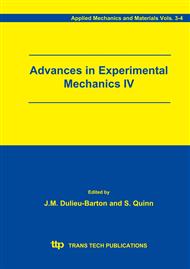p.217
p.223
p.229
p.235
p.243
p.253
p.259
p.267
p.273
Semi Empirical Stress Analysis of a Brittle Material in a Vicinity of a Stress Concentrator
Abstract:
In this study, interaction of a main crack with its surrounding damage, which consists of continuous lines of discontinuities, is analysed. To solve this complex problem, a Semi-Empirical Approach (SEA), which relies on experimentally measured crack opening displacements as the solution to this multiple crack interaction problem is suggested. The solution procedure is illustrated, first, for a particular case of the interaction of an array of horizontal and vertical crazes with a main crack, and second, for the generalized case to include the whole damage of crazing patterns surrounding the main crack. The results show that the crack Damage Zone (DZ) or the socalled Process Zone (PZ) interaction may either amplify or suppress the resulting stress field depending on the crack damage configuration. Green’s function for the Stress Intensity Factor (SIF) is employed to quantify the effects on a crack of the damage of continuous patterns of discontinuities. It follows from the analysis that an increase in the number of crazing patterns will amplify the stress at the main crack. It is also shown throughout this study that the overall effect of the damage is identified, as being an amplifying one and that the resulting local stress field would direct the propagation of the main crack since there is no toughening.
Info:
Periodical:
Pages:
243-252
Citation:
Online since:
August 2006
Authors:
Price:
Сopyright:
© 2005 Trans Tech Publications Ltd. All Rights Reserved
Share:
Citation:


